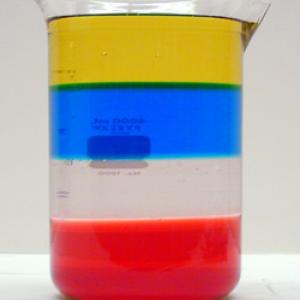College of Liberal Arts & Sciences
2B40.50 - Density Gradient
See also 2B40.50 in Heat and Fluids
24 hrs in advance prepare 3000 ml of saturated salt water. Carefully pour off 900 ml, color red and put in the 4000 ml beaker. The next layer is diluted to 50 percent saturated and not colored. Float the cork pad on the layer in the 4000 ml beaker and using the funnel and eyedropper gently pour the 50 percent layer over the cork so that the layers retain a definite separation. The next layer is 25 percent saturated, colored blue, and added to the beaker in the same manner. The next layer is pure distilled water, colored yellow and added in the same manner. All layers should be of about 900 ml volume. Where the blue and yellow layer mix they will produce a green layer which is why the colors I have designated work best in this order. Now, by heating with a hot plate the bottom layer will boil until it eventually mixes with the next layer which boils and mixes with the next layer etc. If the top layer is chilled and ice added the bottom three layers will be almost furiously boiling before the ice cubes are melted. If undisturbed the layers will remain distinct for several weeks. Initially when you start to pour one layer onto the other it is much easier to use the 60 cc syringe. This offers better control of the volume and speed of the added water thus giving a much more distinct boundary interface.
- Richard M. Heavers, "Oscillations in a Linearly Stratified Salt Solution," TPT, Vol. 45, # 4, April 2007, p. 241.
- Ronald M. Cosby, "Natural Convection in a Stratified Fluid", TPT, Vol. 30, # 7, Oct. 1992, p. 434.
- Ronald M. Cosby, Douglas E. Petry, "Simple Buoyancy Demonstrations Using Saltwater", TPT, Vol. 27, # 7, Oct. 1989, p. 550.
- David F. Paskausky, "Salinity Variation", TPT, Vol. 25, # 2, Feb. 1987, p. 73.
- C. Booth, Tom Beer, and J. D. Penrose, "Diffusion of Salt in Tap Water", AJP, Vol. 46, # 5, May 1978, p. 525.
- Jeff R. Carpenter, Mary-Louise Timmermans, "Temperature Steps in Salty Seas", Physics Today, Mar. 2012, p. 66.
- Tik Liem, "Can Ice-Water Boil", Investigation to Science Inquiry, pp. 204.
- 50 Fun Experiments for the Mad Scientist in You, "Diet Coke vs Coke Floating Smackdown", National Geographic Kids, p. 118.
- William McNairy, "Baffling Buoyancy", 2008 AAPT/PIRA Apparatus Competition, An Entry for the Low Cost Category.
- George M. Hopkins, "Hydraulic Ram", Experimental Science, p. 81.
- John Henry Pepper, Henry George Hine, The Boy's Playbook of Science, p. 53.
- Martin Gardner, "The Mysterious Egg", Smart Science Tricks, p. 19.
- Janice VanCleave, "1: Floating Egg", Teaching the Fun of Physics, p. 9.
- "Daffy Densities", Countertop Chemistry, The Science House, North Carolina State University.
- "Floating Drop of Oil", Unknown Source.
- Janice VanCleave, "Mover", 200 Gooey, Slippery, Slimy, Weird, & Fun Experiments, pp. 153.
- Janice VanCleave, "Sinker", Earth Science for Every Kid - 101 Easy Experiments That Really Work, pp. 196-197.
- #151, "Streamers", Janice VanCleave's 204 Sticky, Gloppy, Wacky, and Wonderful Experiments.
- Joey Green, "Rainbow Machine", The Mad Scientist Handbook, Vol. 2, p. 81.
- Bobby Mercer, "Pop in a Glass", Junk Drawer Chemistry, 2016, p. 85.
- Bobby Mercer, "Mysterious Floating Egg", Junk Drawer Chemistry, 2016, p. 88.
- Guinness World Records, "Saltiest Lake", 2003, p. 78.
- Tik L. Liem, "The Floating Oil Sphere", Invitations to Science Inquiry - Supplement to 1st and 2nd Ed. p. 46.
- Tik L. Liem, "Which Will Float Where?", Invitations to Science Inquiry - Supplement to 1st and 2nd Ed. p. 47.
- Borislaw Bilash II, “Observation of a Density Column“, A Demo A Day – A Year of Physical Science Demonstrations, p. 23.
- Julius Sumner Miller, Q165 & A165, Millergrams II – Some More Enchanting Questions for Enquiring Minds, p. 39 & 95.
Disclaimer: These demonstrations are provided only for illustrative use by persons affiliated with The University of Iowa and only under the direction of a trained instructor or physicist. The University of Iowa is not responsible for demonstrations performed by those using their own equipment or who choose to use this reference material for their own purpose. The demonstrations included here are within the public domain and can be found in materials contained in libraries, bookstores, and through electronic sources. Performing all or any portion of any of these demonstrations, with or without revisions not depicted here entails inherent risks. These risks include, without limitation, bodily injury (and possibly death), including risks to health that may be temporary or permanent and that may exacerbate a pre-existing medical condition; and property loss or damage. Anyone performing any part of these demonstrations, even with revisions, knowingly and voluntarily assumes all risks associated with them.

